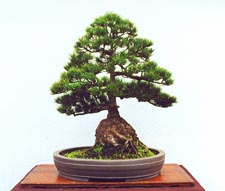Japanese Bonsai
By: Fran Black
The Japanese refined and developed Bonsai techniques and evolved the art
form it is today. For the Japanese, bonsai represents a fusion of strong ancient
beliefs with the Eastern philosophies of the harmony between man, the soul and
nature.
The major aspects of Japanese bonsai, has not changed significantly over time. Japanese bonsai initially originated in Egypt thousands of years ago and moved to China. From China bonsai moved to Japan. Where the Japanese perfected the art of bonsai.
Japanese use azaleas to create magnificent bonsai following years of pruning, wiring and careful attention. The Japanese art of bonsai, and its precursor, the Chinese art of penjing, are rooted in the traditions of Asian culture.
The art of raising bonsai dwarfed potted trees has enabled the Japanese to admire nature in an indoor setting. The art of Japanese bonsai, as developed in America, is much freer in concept and style than Japanese bonsai.
The quality of a bonsai tree is measured on how well it portrays nature in miniature form. A bonsai should have a well tapered trunk and have branches all around the tree to give the bonsai visual depth. The art of Japanese bonsai involves the bringing together of tree and pot in visual harmony. "Bonsai" simply means "potted tree." But many of the really fine specimens have been pruned for more than 100 years.
Requiring many years of devoted attention and care to produce, the bonsai extends beauty and expresses the significance of life. The care involved in creating and shaping a bonsai is considered a form of meditation in and of itself.
Over time, bonsai began to take on different styles, each which varied immensely from one another. Today, hardy as well as tropical indoor bonsai are trained in classic styles, including windswept, slanted trunk, rock clinging, and forest.
Bonsai are highly regarded as a symbol of Japanese culture and ideals. Contrary to popular belief, bonsai are not tortured trees. A bonsai may have areas of dead wood to give an impression of age. There are several techniques available to the bonsai grower to increase the apparent age.
No longer exclusively an oriental art form, today bonsai is practiced by thousands of people around the world, on every continent. The art of bonsai is the art of imitating the spirit of nature. A bonsai industry of considerable size exists in certain sections of Japan.
About the Author:
Francesca Black works in marketing at Bonsai Garden http://www.bonsai-garden.com and Pilates Shop http://www.pilates-shop.net leading portals for bonsai gardening and natural exercise.
Japanese Culture and Society Links
Japanese Sports 競技 (スポーツ)
Japanese Food 食品 (しょくひん)
Japanese Pop Culture 文化(ぶんか)
- Hello Kitty Phenomena
- Japanese Anime, Japanese Manga
- Japanese Hair Straightening: All You Ever Wanted to Know
- Kawaii
Miscellaneous
- Creating a Japanese Garden Theme
- Keeping and Handling Japanese Inro
- Misconception about Ninja
- Japanese Bonsai
- Japanese Geisha
- Japanese Wedding
- Why Do Japanese Have Long Lifespan?
- Decorate with Japanese Art
Japanese Literature Links
- Haiku Poetry
- Japanese Alphabet
- Japanese Language
- Japanese Pronunciation
- Learning Japanese Kanji
- Tanka Poems
Japanese Art Links